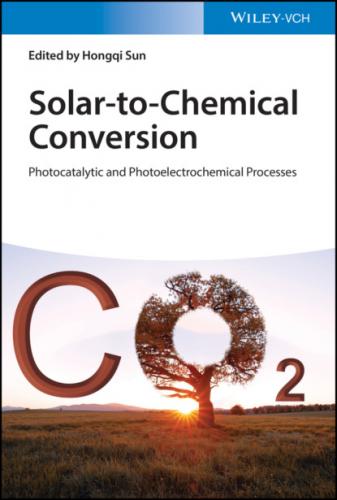Solar-to-Chemical Conversion. Группа авторов
Читать онлайн книгу.parameters of MIL‐125‐NH2, MIL‐125‐R7, and OPA/MIL‐125‐NH2. Source: Kawase et al. [31]. © 2019, Royal Society of Chemistry.
7 Chapter 13Table 13.1 Reaction categories involved in photo‐mediated catalysis and related Gibbs free energy.Table 13.2 Hydrogen or methanol yield in methane steam reforming reaction using various photocatalysts.Table 13.3 Methane coupling reaction with photo‐assisted catalysis.
8 Chapter 14Table 14.1 Photocatalytic conversion of processed lignin in literatures. Source: Liu et al. [49]. © 2019, The Royal Society of Chemistry.Table 14.2 Photocatalytic conversion of cellulose in literatures. Source: Liu et al. [49]. © 2019, The Royal Society of Chemistry.
List of Illustrations
1 Chapter 2Figure 2.1 Schematic of solar fuel feedstocks (CO2, H2O, and solar energy) and production path on‐site and/or transported to the solar refinery [4].Figure 2.2 Schematic diagrams of (a) natural photosynthesis and (b) artificial photosynthesis based on molecular systems. Source: Liu et al. [9].Figure 2.3 (a) Traditional catalytic processeson the surface of catalysts. (b) Classic photocatalytic paths over photocatalysts.Figure 2.4 A band‐gap diagram showing the different sizes of band gaps for conductors, semiconductors, and insulators.Figure 2.5 Proposed mechanism of photocatalytic reactions on semiconductor photocatalysts. Source: Ma et al. [16].Figure 2.6 A schematic illustration of the energy correlation between semiconductor catalysts and redox couples in water. CB and VB denote a conduction band and a valence band, respectively. Source: Tu et al. [20].Figure 2.7 (a) Yields of the products produced during the photocatalytic reduction of CO2 with H2O and photoluminescence of various Ti/FSM‐16 photocatalysts. (b) Product distribution of CO2 photoreduction over 1‐TiO2, 2–10 wt% imp‐TiO2/Y‐zeolite, 3–1.0 wt% imp‐TiO2/Y‐zeolite, 4‐ex‐TiO2/Y‐zeolite, and 5‐Pt‐loaded ex‐TiO2/Y‐zeolite. (c) Schematic mechanisms of the photocatalytic CO2 reduction with H2O on TiO2. Source: (a) Ikeuea et al. [23]; (b) Anpo et al. [22]; (c) From Anpo et al. [21]. © 1995 Elsevier.Figure 2.8 Schematic cycle for the photosensitized reduction of CO2 to CH4. Source: Maidan and Willner [25].Figure 2.9 (a) Calculated band structures and total density of states of BMO‐OVs. Absorptive formats of CO2 on BMO‐OVs (b) and BMO (c). CO2 reduction pathways on BMO‐OVs (d) and BMO (e). (f) The diagram of band positions. (g) CH4 production and the TCEN value for CO2 photoreduction over the BMO‐OVs and BMO during four hours visible‐light irradiation. (h) Typical time course of CO/CH4 generated over BMO‐OVs. Source: Yang et al. [30].Figure 2.10 (a) Schematic illustration of the solar‐assisted production of methanol from CO2 and water through a three‐enzyme cascade. (b) Methanol production as a function of time in multienzymatic systems. (c) Photoelectrochemical production of methanol by TPIEC under various applied potentials under visible‐light illumination. (d) Methanol production of the TPIEC system in various multienzymatic systems with an external voltage of 0.8 V. Source: Kuk et al. [41].Figure 2.11 (a) Mechanism for the reduction of CO2 by photocatalysis under visible light with a Ru complex and an N‐Ta2O5 hybrid catalyst. (b) Turnover number for HCOOH formation from CO2 over various molecular systems as a function of irradiation time. (c) Schematic mechanism of visible‐light‐driven photocatalytic CO2 reduction over RuP/NS‐C3N4 hybrids. (d) Time courses of photocatalytic CO2 reduction using RuP/NS‐C3N4‐PU0 and RuP/NS‐C3N4‐PU90 under visible light (λ > 400 nm). Source: (a) Suzuki et al. [55]; (b) Sato et al. [55]; (c) Tsounis et al. [56]; (d) Tsounis et al. [56].Figure 2.12 (a) Scheme of the photocatalytic CO2 reduction over CdS/(Cu–NaxH2−xTi3O7) irradiated by light. (b) Gas evolution rates of C1–C3 hydrocarbons on CdS/(Cu–NaxH2−xTi3O7) as well as the specific surface area, where the Na/Ti ratios were 0.093 (low), 0.143 (medium), and 0.507 (high). (c–e) Mass spectra of the formed hydrocarbons (methane, ethane, and propane) with the labeling of 13C. (f) Proposed elementary reaction mechanisms of photocatalytic CO2 conversion into hydrocarbons. Source: Park et al. [64].Figure 2.13 Structures of CN before (a) and after (b) doping with carbon chains. (c) Electrochemical impedance spectroscopy (EIS) Nyquist plots under irradiation condition. Inset: Periodic on/off photocurrent response under visible‐light irradiation. (d) Comparison of the photocatalytic CO2 reduction rate of the samples with different amount of glycine, respectively. Source: Ren et al. [70].Figure 2.14 (a) Gas production under six hours visible‐light irradiation of pure Cu2O and Cl‐doped Cu2O samples. (b) Mass spectrum from the 18O‐labeling H2O isotope experiments of Cu2O–Cl‐4. (c) Time‐dependent product evolution over Cu2O–Cl‐4 under visible‐light irradiation. (d) Stability test of Cu2O–Cl‐4. (e) Proposed reaction pathways of CO2RR to CO and CH4 on Cl‐doped Cu2O. Source: Yu et al. [83].
2 Chapter 3Figure 3.1 The light‐dependent reactions of photosynthesis produce protons and electrons used in the conversion of CO2 to carbohydrates (CH2O) and other organic compounds, while oxidation of these organic compounds (biomass, food, fuels) by respiration or combustion releases the stored solar energy to power the metabolism of non‐photosynthetic organisms and drive human technologies.Figure 3.2 Schematic membrane arrangement of enzymes involved in the light‐dependent reactions of oxygenic photosynthesis. Red arrows indicate the flow of electrons from the primary electron donor H2O to the final electron acceptor NADP+ aided by photoexcitation in photosystems II and I. Electron flow is tied to proton translocation across the membrane. The proton gradient created by accumulation of protons in the interior of the membrane powers the synthesis of ATP.Figure 3.3 Selected types of chlorophyll molecules encountered in natural photosynthesis.Figure 3.4 (a) Side and top view of the light‐harvesting complex LH2 from the purple bacterium R. acidophila 10050 (PDB: 1KZU [24]), showing bacteriochlorophyll a pigments in green and carotenoids (rhodopin glucoside) in orange. (b) Rod structure of c‐phycocyanin from the phycobilisome light‐harvesting antenna of cyanobacterium T. vulcanus (PDB: 3O18 [25]). (c) Light‐harvesting complex II (LHCII) from pea (PDB: 2BHW [26]), showing Chl a pigments in dark green and Chl b in light green.Figure 3.5 Examples of synthetic approaches to multi‐chromophore arrays: (a) a nine‐porphyrin array unit comprising a central free‐base porphyrin core that acts as final acceptor and is surrounded by eight energy‐donating zinc porphyrins [43]. Source: Choi et al. [41]Figure 3.6 Simplified Z‐scheme of natural oxygenic photosynthesis, showing how two photons are used per electron flowing from the terminal donor (H2O) to the terminal
